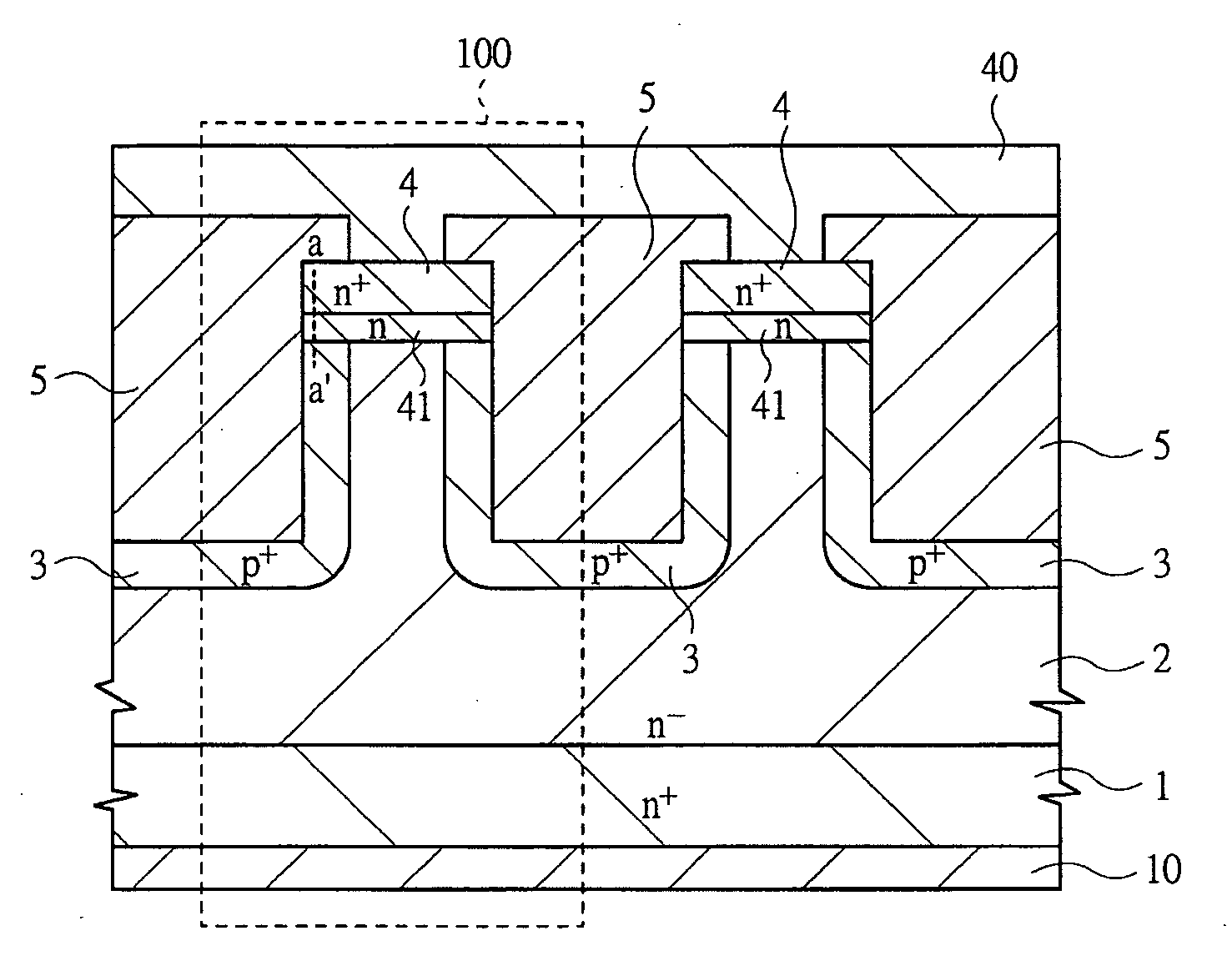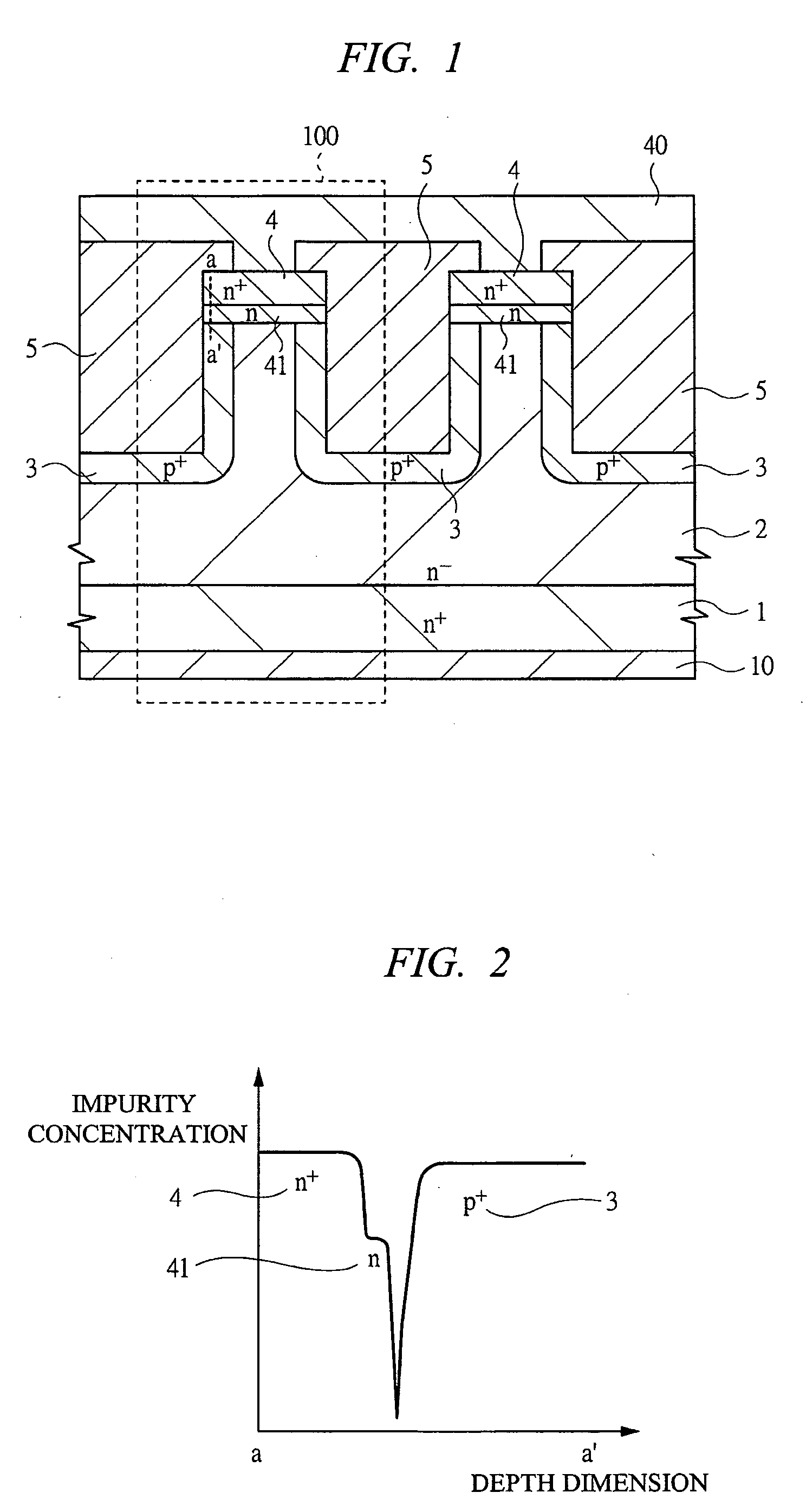Switching semiconductor devices and fabrication process
a technology of semiconductor devices and fabrication processes, applied in the direction of semiconductor devices, basic electric elements, electrical equipment, etc., can solve the problems of unnecessary voltage drop, increase in gate voltage, increase in on-resistance, etc., to avoid an erroneous operation of a jfet
- Summary
- Abstract
- Description
- Claims
- Application Information
AI Technical Summary
Benefits of technology
Problems solved by technology
Method used
Image
Examples
first embodiment
[0044]FIG. 1 is a sectional view of a switching semiconductor device according to a first embodiment of the present invention. The switching semiconductor device according to this embodiment is fabricated by using a semiconductor substrate having opposing first and second surfaces and a band gap of 2.0 eV or more. The switching semiconductor device includes: an n+ type source region 4 with a high impurity concentration extending to the first surface in this semiconductor substrate; an n+ type drain region 1 with a high impurity concentration extending to the second surface in this semiconductor substrate; an n− type drift region 2 with a lower impurity concentration than those of the source region 4 and the drain region 1, which is adjacently formed between the source region 4 and the drain region 1 in the semiconductor substrate; a trench 5 formed to extend to the first surface in this semiconductor substrate; and a p+ type gate region 3 with a high impurity concentration, which de...
second embodiment
[0047]FIG. 3 is a sectional view of a switching semiconductor device according to a second embodiment of the present invention. In the switching semiconductor device according to this embodiment, a source region 42 with a low impurity concentration is provided around the source region 4 with a high impurity concentration, and a main region through which a current flow is the n+ type source region 4 with a high impurity concentration. Therefore, in this embodiment, a semiconductor device with a lower ON-resistance compared with the first embodiment can be achieved.
[0048] More specifically, the source region includes: n type source regions 42 distributed into a plurality of island regions each surrounded by and in contact with the gate region 3 and having an impurity concentration lower than that of the gate region 3 and higher than that of the drift region 2 at portions in contact with the gate region 3; and the source region 4 adjacent to this source region 42 and having an impurit...
third embodiment
[0050]FIG. 5 is a sectional view of a switching semiconductor device according to a third embodiment of the present invention. In the switching semiconductor device according to this embodiment, a low-resistant gate electrode 30 ohmic-connected to the p+ type gate region 3 provided at the bottom of the trench 33 is formed in a plug shape so as to fill the trench 33. This gate electrode 30 is preferably formed of tungsten W, molybdenum Mo, aluminum Al, nickel Ni, or a compound thereof. Alternatively, the gate electrode 30 can be formed of a low-resistant polysilicon. By this means, since the p+ type gate region 3 is shunted by the low-resistant gate electrode 30, gate resistance components viewed from the gate terminal of the semiconductor device (not shown) are significantly reduced. Accordingly, in this semiconductor device, the voltage fluctuation due to a noise current of the p+ type gate region 3 can be easily suppressed by using a negative gate voltage applied from the gate cir...
PUM
 Login to View More
Login to View More Abstract
Description
Claims
Application Information
 Login to View More
Login to View More - R&D
- Intellectual Property
- Life Sciences
- Materials
- Tech Scout
- Unparalleled Data Quality
- Higher Quality Content
- 60% Fewer Hallucinations
Browse by: Latest US Patents, China's latest patents, Technical Efficacy Thesaurus, Application Domain, Technology Topic, Popular Technical Reports.
© 2025 PatSnap. All rights reserved.Legal|Privacy policy|Modern Slavery Act Transparency Statement|Sitemap|About US| Contact US: help@patsnap.com



